Building Our House VII
As the year comes to an end, we thought it might be a good time for another report on the building of our house in Merida. No, it's not finished yet. Since we started, our architect, Mercedes, has had time to get pregnant and have her baby (Bienvenido al mundo, Rodrigo!), but the house remains unfinished. It isn't scheduled to be finished until the end of February, so this is not yet a cause for alarm.
As we prepared to write this article, we read our last article (Building our House VI). Looking at the photos, even our reaction was "Well, not that much has changed in two months!". And it's true. The broad strokes of building concrete walls, shelving, tejebans, pools and floors has been done for awhile. The last floor finish to be done will be the stone patio between the office and the kitchen, and the stone is set for delivery the day after Christmas. But in general, we are now down to the detail work... what our architects call "the endless end", which we imagine would be fin sin fin in Spanish... a very poetic and valuable expression at this stage.
So what has happened since our last report?
Blinded by the Light
Wandering through our house late one night after working all day, we stepped into the guest bedroom and we noticed light streaming through the window. The streetlight is meters and meters away, but it was shining brightly right into the space that will one day hold a guest bed. We considered buying a BB gun and making short work of the lamp, but decided that would probably not get us off on the right foot with the neighbors. Instead, we talked with the architects the next day and arranged to build a small wall above the roof near the front of the house which would block the light. The architect had a few design suggestions, and the end result is an arched nicho (niche) with a bench in front of it, which not only blocks the light but makes a perfect place to sit and look back at the house we have built. A little problem solved where the solution turned out to be an unexpected gift.
Laundry sinks
The laundry room has been completed (except for paint and actually installing the washer and dryer). We covered the sink with ceramic tile (which we don't particularly like and don't have anywhere else in the house) as we were advised that it holds up the best under cleaning fluids like bleach. We also installed a "Mexican-style" cement sink, as opposed to a "Yucatecan-style" sink. The Yucatecan style sink is rectangular, with a washboard-like surface on the bottom, and it tips to one side. We've seen them in the most remote pueblos and in the laundry rooms of some of the most expensive homes here. The Mexican-style sink is actually two side-by-side sinks, one for soaking and one with the built-in washboard bottom. Who knew? In any case, they were both available pre-made from the same concrete store that makes columns, molding and other pre-cast concrete and cement items. By the way, these cement items are very inexpensive. As we recall, the sinks both cost about $100 pesos (that's less than $10 US).
Iron Men
Our architects hired two different iron workers to work on our house. The doors upstairs facing the patio with the outdoor bathtub were done by one man, who did a markedly sloppier job than the other iron worker. His doors didn't seem quite as well put together, and when he installed his work, he made a lot of unnecessary holes in the walls. Upon observing that, our architects repaired the damage and gave the rest of the doors and windows to the second iron worker. His work has been neat, careful and consistent. In the past two months, he has built and installed bannisters for the inside staircase, the divider between the living and dining rooms and for the stairs next to the pool. He's also built the three arched iron doors leading into the kitchen and dining rooms, as well as the rectangular-paneled doors for the living room and master bedroom, which
are at this moment resting in the pasillo, waiting to be installed. This man is also creating the custom-designed chandeliers (seven of them!) which are going to light the pasillo. Of course, we have now given him a lot more work than he was anticipating, so he's now a bit behind schedule. We're also waiting for Don Martín, the electrician, to actually electrify the first prueba (test) chandelier, install the focos (lightbulbs), and install the chandelier in place to make sure we like the way it looks. If all goes well, the iron man will then proceed to make the other six. If not, back to the drawing board.
Polishing
The floors upstairs (and many of the downstairs floors too) have all been polished at least once or twice. Apparently, there is an ongoing debate amongst Yucatecan contractors about whether to polish or paint first. We elected to begin polishing first, to guard the tiles and white cement against any unwanted staining, not just from paint, but also from general wear and tear and the occasional bat that decides our empty house makes a great cave. The white cement counters in the bathrooms and master bedroom are also being polished, as are the yellow counters and shelving in the kitchen. Even the white cement walls in the bathrooms will be sanded down and slightly polished, then sealed to prevent cracking or staining as much as possible. From what we can tell, polishing is an intermittent and ongoing process. The men use both machines and elbow grease, depending on what is being polished. In the end, those mosaico tiles and the cement surfaces shine and glisten. It is quite a transformation.
Chips Off of Many Old Blocks
A lot of work has been done on the floors in the past two months. The long pasillo which reaches from the front of the house in the garage to the back of the property, has been floored with diamond-shaped areas of grey cement, separated by rows of white chipped stone, called rajuela. Rajuela can be any color; the term refers to the style of placing chipped stones side by side. We ended up using rajuela for the pasillo floor, for the water wall that is the focal point of the swimming pool, and as the backdrop for our Virgen de Guadalupe statue that graces the courtyard fountain. (We found our Virgen on the road from Tulum to Valladolid. It was created by the men who have a roadside store set up at about 15 km inland from Tulum.) The work of creating rajuela is tedious, as the large stones must first be chipped into small pieces, and then painstakingly set into place. The result is beautiful, but we pity the workers who have been doing those rajuela lines in the floor for what must seem like centuries now! Our plain grey cement floors look beautiful with the rajuela delineating the diamond shapes, and they rhyme with the diamond layout of the saltillo tiles in our patio and next to the pool... an unintended but very harmonious effect, if we do say so ourselves.
The Back Forty
After all the tile work had been completed, which included Talavera tiles in kitchens and bathrooms, and mosaico tiles on most floors (in combination with white cement), we took the leftover pieces and created a cement potting table in the back area behind the pool. Hidden from view, this table also takes advantage of unused column pedestals for its base. With the big garden and all the outdoor terraces this house has, we think we're going to put this table and this area to good use.
The area behind the pool is where the pool equipment (regular pool filter, additional saline filter, pump for the pool and pump for the "water wall" fountain that flows into the pool) is now partially installed. We also built two concrete bins in that area for holding and processing compost. All this will be hidden from view from the house but easy to access.
In an informal ceremony last week, we created a sort of monument on the wall behind the pool to the trajabadores (workers) who have built this house. We ordered lunch from a place we've found that delivers great lunches (Burrito Express, 926-7851...try it!). Forty burritos arrived individually packaged and labeled... an easy and tasty solution for serving such a big crowd. After lunch, we invited each worker (there were 33 of them) to put his handprint in black paint on our garden wall, and to print his name underneath. Our architects, our assistant Beatriz and we added ours as well. The result is a line of black handprints on our wall, reminiscent of the ancient Mayan handprints you sometimes find in caves in the Yucatan, and a meaningful tribute to the men (and a few women) who built this house.
The same day, we also planted our first tree. A ceiba tree (which was given to us by our friend Lucy from Selva y Jardin) was planted carefully, far enough away from the wall so it can grow for twenty or thirty years (or more!) without damaging it. Working Gringo sprinkled a few drops of ceremonial Coca Cola on the ground, and we welcomed the tree to her new home. A few volunteer native palms that were hardy enough to have survived the last six months of abañile basura being thrown on them were also dug up and replanted along the wall. It has been many months of rock, tile, dirt and dust, so it was a real pleasure to see a few spots of green going into the back yard.
Kitchen
The island in the kitchen, made of colored and polished cement, has been finished for awhile. Ditto the yellow cement shelving along one wall, and the kitchen counters along the other wall. A few weeks ago, the younger half of our father-son carpenter team came by to get our approval on the kitchen cabinets and discuss the color of the stain. We settled on all that and last week, the kitchen cabinets showed up and were installed. We rushed out and bought handles (at a great store called Jako across from Costco), and we're very pleased with the results. The carpenter will probably finish the installation the week after Christmas. The doors and windows to the kitchen are all made of iron and glass, for maximum visibility to the outside world (and maximum ease of maintenance too). The iron is in (see the first photo in this article), but still needs to get the final coat of paint and to have the glass installed. Once that is done, the walls will be painted, the fan hung, the stove and sink installed (all waiting in the wings for their grand entrance...) and we'll be cookin'!
Appliances
We have purchased a number of appliances for our new house. Thanks to a growing number of U.S. chain stores here in Merida, we've had no problem finding familiar brands from back home. These stores include Walmart, Sam's Club, Home Depot, Sears and Costco. There are also a number of Mexican stores where you can shop for appliances. The most well-known of these is Liverpool. As you can imagine, we've spent a number of hours shopping around and have found the lowest prices at Costco. However, another important consideration is maintenance and repair, so we are careful not to buy a brand from Costco that is not well supported by authorized dealers in Mexico. As it turns out, the only U.S. branded appliances we've purchased are the washer and dryer, manufactured by Whirlpool. Our stove is actually a popular Mexican brand called Mabe. All of our air conditioners, as well as our refrigerator, are made by a company called LG. We had never heard of LG before moving here, but we have come to appreciate the reliability and affordability of their products. Plus, you'll never have any trouble finding someone to service an LG appliance.
What Lies Ahead
There are a lot of things that are partially completed that need to be finished. The largest jobs that lie ahead are the painting, the garage door, the landscaping and irrigation, the stone patio and the chicum finishes.
>
We have employed our painter, Isauro, who we have used over the years for repainting the interior or exterior of our former home, Casa del Panadero. He is a very good painter and he and his team are both good at what they do and neat about it. Before we started painting, we asked Isauro for a presupuesto because he is not working under our architects, but directly for us. He walked around our house and measured every wall and ceiling. His final presupuesto came out to about $76,000 pesos, roughly $25 pesos per square meter. We have agreed to pay him based on work he accomplishes, so each Saturday, we go through the house, counting what has been done, and then we pay accordingly. This arrangement seems to be working out well.
Another worker who we wanted to employ directly is Carmelo, the man who did our stone patio at Casa del Panadero. In his case, he is so busy installing over 3,000 square meters of cut stone at the new Yucatan Golf Club, that he said he could only provide the stone. We would have to ask our albañiles to install it. So we arranged for our architect to visit him on the jobsite to understand the process. And the stone will be delivered this week: 40 square meters of it for $32,000 pesos. A lot more expensive than the paint! We're budgeting another $4,000 pesos to install it. We've been told our albañiles earn between $125 and $200 pesos a day, so this is about 25 man-days of installation. Hopefully it will go a little bit faster than that!
The other main job still left to be done are the chicum finishes on the pool, the outdoor bathtub, the bar and the two outdoor cement banquets. Our former home had a plunge pool covered in chicum finish. It is an ancient Mayan technique of mixing white cement with secret ingredients which may or may not include an extract of chicum tree bark, cement, Coca-cola, urine, water and honey. Whatever it is made of, it has a lovely honey color (as compared to the greyish white of plain white cement) and it is especially water resistant. On top of that, it ages really well, developing a lovely mottled patina that we think looks ancient and very rich. That's the good news. The bad news is that there are very few people who know how to make the chicum concoction, and it costs about $25 pesos per square meter as opposed to white cement which costs about $15 pesos per square meter. It's more expensive, but we know it will be worth it.
The garage door has been co-designed with our architect and is being built by yet a third iron man. He has been telling us it will be deilvered any day now for a few weeks. So we suspect we'll see it any day now.
The landscaping and irrigation is a big "to do" on our list. Our architects have a gardener who can come in and dig holes and plant plants. But we need to come up with a general outline of what we want in our garden, and then have the irrigation designed and installed. We plan to plant a few big trees, a big patch of grass and a few palms, heliconias, gingers and bananas to start. Then we'll let the rest grow somewhat, well... organically!
Everything else that needs to be done now is partially done. Some lighting fixtures are in, some plumbing fixtures have been installed. Some white cement walls and mosaico floors have been polished. Some metal and glass doors are installed. Some wooden doors have been refurbished and installed. Some of the kitchen cabinets have been installed. Some of the pool equipment is in. Some of the water system has been installed. Finishing up all these little things are going to drive us crazy for sure. We can't wait to move in, but they don't call it the fin sin fin for nothing. Wish us luck!
To read the past progress of our house project, here are the links:
Building Our House VI
Building Our House V
Building Our House IV
Building Our House III
Building Our House II
Building Our House




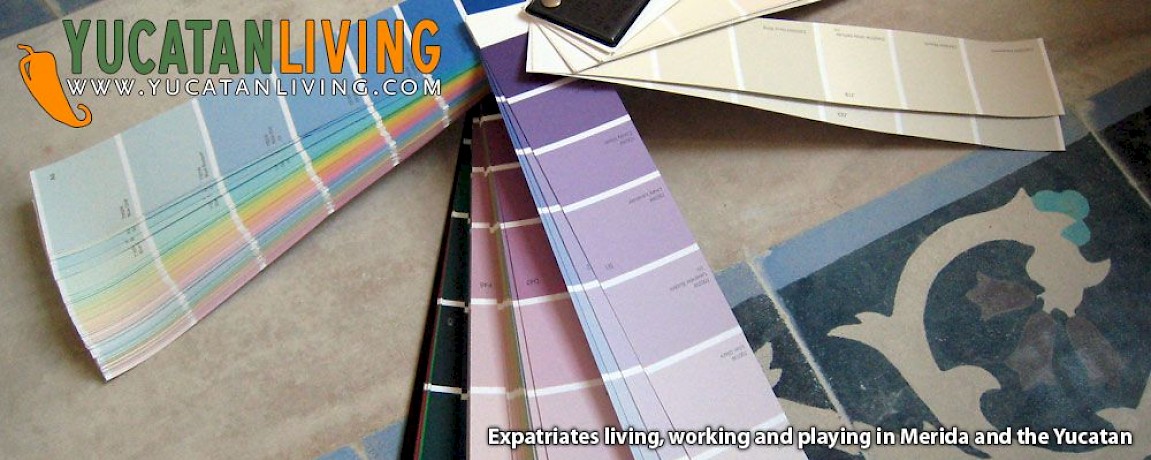



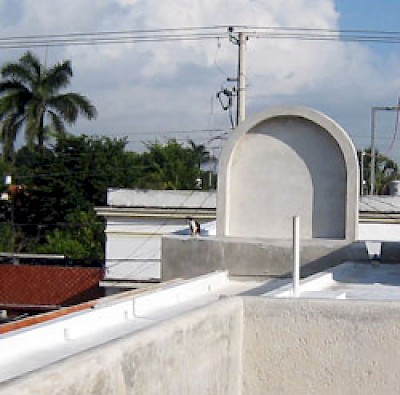
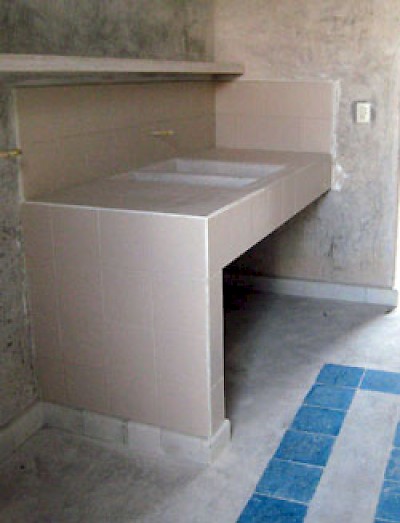
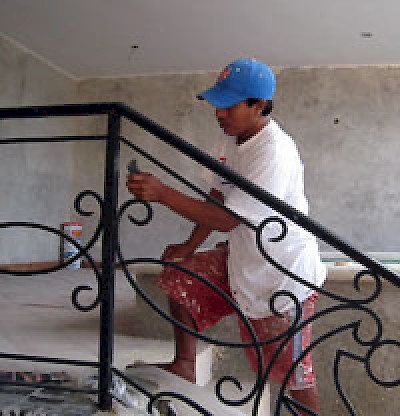
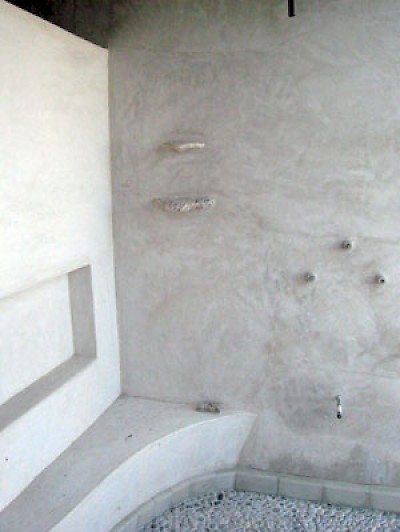
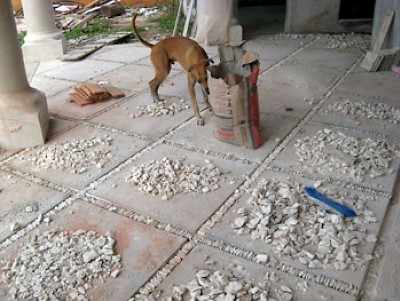

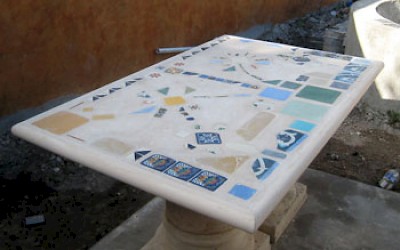
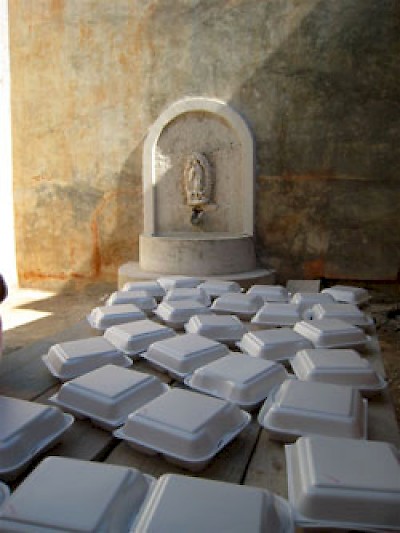
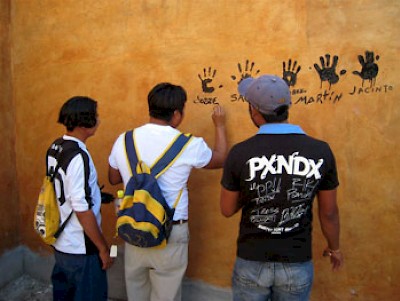



Comments
Anita Saganich 17 years ago
Hello wonderful people, we need help. We are in San Cristobol Chiapas currently and have a home in Chuburna. It is one street off the beach and has been all redone (what they say is Americanized. It is one bedroom (huge) we have a sitting room and queen bed, two antique roperos, loveseat, recliner... you get how big. Living room, dining room, kitchen, new back porch, new concrete roof, instant-on gas hot water heater and brand new baño.
WE NEED TO SELL! My health has never been good, but now it is horrible. We are asking $55,000 USD but will consider an offer today! It is completely furnished, pans, dishes, brand new fridge, stove, bed and washing machine. It has a new tinaca, pozo, and storage in the back yard. It has been updated with screens, antigue doors, etc. Please help us to sell the place we love and are crying about now.
The most important part is the neighbors. We have several American, Canadian and Hispanic couples that are the lifelines you need when you are new to a foreign country. The address is Calle 7A #332A. The house is blanco y violeta off the Huanchanango exit from Chelem to Chuburna. Walk around and then call the number on the notice. Our phone number is 999.215.7558 and there is another number listed at the house if you go out to see it.
In Christ´s Love,
Anita & Ricardo Saganich
Reply
chris 17 years ago
I am continually blown away by your generous sharing of your process of homebuilding and living in Merida! My mother in law lived in Progresso for nearly 12 years many years ago and then Merida for a year more recently with the intent of staying for the remainder of her life. Circumstances changed and she is now back in Alaska with all of us. I and my husband are now seriously investigating buying and renovating in Merida with the intent of living there 6-7 months of the year until retirement and then more year round. It would be a dream for my mother in law to be able to return there one day. I hope we can help that dream come true! All of that to say that reading your blog/articles has been so much more than helpful. I am eager to learn from your experiences. We will not be renovating or building on the scale that you have but I have gleaned immeasurably from your generosity of spirit!
Muchas Gracias!
Reply
Jay 17 years ago
Does anyone know how one can ship just an a few pieces of furniture from the U.S. to Merida? I don't have enough for a complete shipment and have had no luck with calling around.
Reply
Ray 17 years ago
Are you all moved in and settled now?
Reply
Working Gringos 17 years ago
CasiYucateco,
The material in the pool and fountain at Temozon is chicum, which is made from white cement, water and resin boiled from the bark of the chicum tree. It's rumored that there are other secret ingredients, but we can't find anyone who will confirm them. Its appearance can range from almost white (the color of masking tape) to a dark tan (the color of almonds), depending on the ratio of white cement to chicum. It is almost impossible to thoroughly mixed the chicum and white cement (sort of an oil and water thing), so the finish is often lightly mottled.
We have been told by reliable sources that it was originally introduced by the Maya as a waterproof plaster, used espeically as the finish inside a chaltun, or underground cistern.
While it does feel softer than concrete, like Salitillo tile, it is not maleable. It chips just like cement. But if you were standing in a pool, you may have been feeling a thin surface of sediment that had filtered to the bottom.
Reply
CasiYucateco 17 years ago
Is Chicum material sort of flexible or just a little soft to the touch?
I once swam in a pool at a hacienda (one of those Banamex restored jobs). The pool had a wonderful finish to it, a little blue-grey-beige (hard to describe the color) that felt like walking on rubber or something. It was just a touch maleable. You talk about 'polish and seal' but I don't know if the material I experienced was hard enough to be polished. hmmmm... It's a mystery. All along, I thought it was chicum, but your description makes me doubt myself.
(Hacienda Temozon, I just remembered!)
Reply
Working Gringos 17 years ago
Sergio, the price quoted was for materials and labor. The work turned out very well. It needs to cure and stay dry for a couple weeks before they come back to polish and seal it, but it has rained very heavily a couple times, so we're still not quite finished. We'll post contact info for our "chicum guy" in our next article.
Reply
Sergio 17 years ago
I was curious about that chicum price you listed. Is that just for the material to make it or does it include the labor to put it in?
Reply
Lance LeGrassio 17 years ago
I have spent many a night at casadelosvenados and it is simply to die for. Tremendous host that know how to fill every "nook and cranny".
Reply
tusreba 17 years ago
I had wondered how the house building was going. It sounds like it is almost there.
I loved what you put in in housebuilding 6 as to the human artistry vs the mechanized.
There is much to be said for the human touch. I am so glad you have honored the artists with the wall as you did.
Mom
Reply
John Venator 17 years ago
WOW!
Loved the article - since we too have been involved with a house renovation now finally getting finished after 7+ years - simply becuasee it is a BIG project converting a 400+ year old hacienda style house that had been abandon for 40 years. I too would love to see some of your on-going photos. We don't have such an extensive narrative, but we did hae the forsight to take lots and lots of photos over the years.
We too just bought our kitchen appliances: whirlpool and GE and LG for the same reason - access to maintanence service. All of our 16 (to date and counting) mini split air conditioners are also LG and we are VERY happy with them!
You can see what we started with on October 10, 2000 and what it is now by going to www.casadelosvenados.com and going to the photo album section.
Later this year we hope to be close to being near completion as far as the original vision for the house. Of course, anyone who has an "edifice complex" knows that a house is a hobby and ideally never truly finished.
John and Dorianne Venator
Reply
« Back (10 to 21 comments)Next »